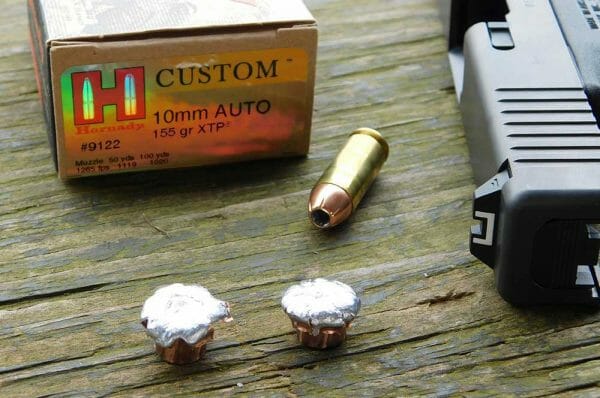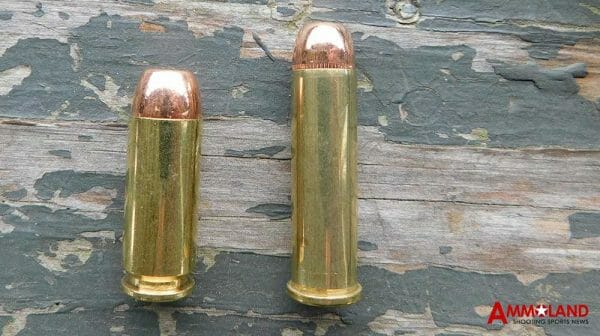Please check out our other review of 10mm auto ammunition found here.

USA – -(Ammoland.com)- Despite its thirty-plus years of existence, only now is the 10mm Auto Ammunition getting its due. The future is looking to be good for the 10mm auto ammunition, with new pistols being released to the market, turning smoldering coals into a fire.
10mm Auto Ammunition
The 10, however, is still new to many and whether you like it or not, now is as good a time for a refresher.
-

Col. Jeff Cooper, 100mm’s OG If one person is responsible for the 10mm Auto’s existence, famous writer, and pistolero Col. Jeff Cooper is the guy to blame. Conceived as a magnum cartridge for semi-automatic pistols, the 10mm was suggested by Cooper and in cooperation with Michael Dixon and Thomas Dornaus to produce a pistol rugged enough to handle the round. The Bren Ten pistol that resulted became a cult classic, despite lackluster sales in its 1983-86 production run.
- The 10mm had a brief career as the FBI’s cartridge of choice. In the aftermath of the 1986 Miami FBI Shootout, the FBI decided to pick a new cartridge that would be in a platform that reloaded faster than the 38 Special revolvers and with more punch than the 9mm pistols fielded on that fateful day. The 10mm threw a bigger bullet faster than those rounds, and it was built for faster reloading semi-auto pistols. Large framed pistols like the Smith & Wesson 1006 series were adopted. This trend didn’t last long, however.
- The 10mm gave birth to the 40 S&W. In short, the adoption of the 10 by the FBI was a knee-jerk reaction. The round’s recoil and blast made it hard to shoot well, and the round was loaded lighter in response. By 1990, Smith & Wesson used this downloaded 10mm and shortened its case to fit into the grip of a conventional 9mm pistol. Hence, the 40 S&W was born. The 40 is still powerful, but it boasted lower recoil and could be chambered in traditional auto pistols. The FBI was quick to adopt this round, and many police agencies followed suit.
- The 10mm is based upon a rifle round. The .30 caliber Remington was a medium power cartridge like the 30-30 Winchester round. The main difference is the 30-30 has a distinctive rim for extraction, while the 30 Remington has a recessed rim for easy use in auto-loading rifles. The 30 Remington brass is shaved down into the straight-walled 10mm Auto round.
- The 10mm is controversial in the self-defense role. The 10mm propels a 40 caliber bullet about 180 grains at between 1200-1400 feet per second, rivaling or surpassing the 357 Magnum revolver cartridge depending on your load. Thus, there is something of a bias against the 10mm as being too powerful for defensive use. The famed trial of the late Harold Fish is a firm example of this. Fish’s story had some inconsistencies, but during the trial, his claim of self-defense was challenged because of his use of a 10mm pistol. The prosecution claimed Fish intended to kill by using such a powerful handgun.
-

10mm Auto Ammunition (L) with close cousin pal, .357 - The 10mm excels in field use. Pistols chambered in the round have proven themselves adept at both handgun hunting and protection in the bush. Over a conventional medium framed magnum revolver, 10mm pistols, on the whole, carry more ammunition and be lighter on the hip. Those saved ounces matter on a long rendezvous.
- The concealed carry market has a 10mm undercurrent. The vast majority of 10mm pistols are large framed handguns based on the CZ75, 1911, or full-sized 10mm Glocks. However, there has been a trend toward stuffing the 10 into something more compact. The Glock 29 subcompact pistol has been around for a while and is a proven performer. Others like the newer EAA Witness Compact are out there, and the continuous caliber debate will undoubtedly spur the new interest in the round into new and dangerous territory.
- Ammunition variety is expanding, but still elusive on shelves. Just about every ammunition manufacturer has a few 10mm Auto loadings out there. You can get a multitude of full metal jacket practice ammunition to defensive hollow-points to flat-nosed heavy grain bear loads. Unfortunately, finding anything other than practice ammunition at your local sporting good stores can be elusive. A few short years ago, it was rare to encounter any 10mm ammunition at all, so the round’s stock is improving.
- 10mm factory ammunition can disappoint. What do I mean by that? Ask any 10mm aficionado, and they will tell you that factory 10mm ammo is loaded lightly. The reason for this has little to do with liability, but the fact that data used with the FBI’s lighter-loaded 10mm ammunition is used rather than the actual Norma specs that Cooper envisioned. This is especially true, in my experience, with practice ammunition whose velocity is hardly different from 40 S&W. Velocity is substantially raised when using defensive hollow-points and bear loads.
- Pistols are hard to find and more expensive. The web has everything you could want in 10mm, but it is hard to translate it to stores. Big box operations and mom-n-pop shops are more likely to stock the current mainstream handguns in familiar defensive calibers like 9mm, 40 S&W, or 45 ACP. Despite the new interest in 10mm, seeing one on a shelf is unusual. What isn’t usual is the higher sticker price you can look forward to paying when you do find one. When power is the name of the game, it is easier to find magnum revolvers and ammunition to fire them.
About Terril Hebert:
Terril Hebert is a firearm writer native to south Louisiana. Under his motto—Guns, Never Politics—he tackles firearm and reloading topics both in print and on his Mark3smle YouTube channel, where he got his start. Terril has a soft spot for ballistics testing, pocket pistols, and French rifles. When he is not burning ammo, he is indulging his unhealthy wildlife photography obsession or working on his latest novel. Scourge of God, published in 2017.
